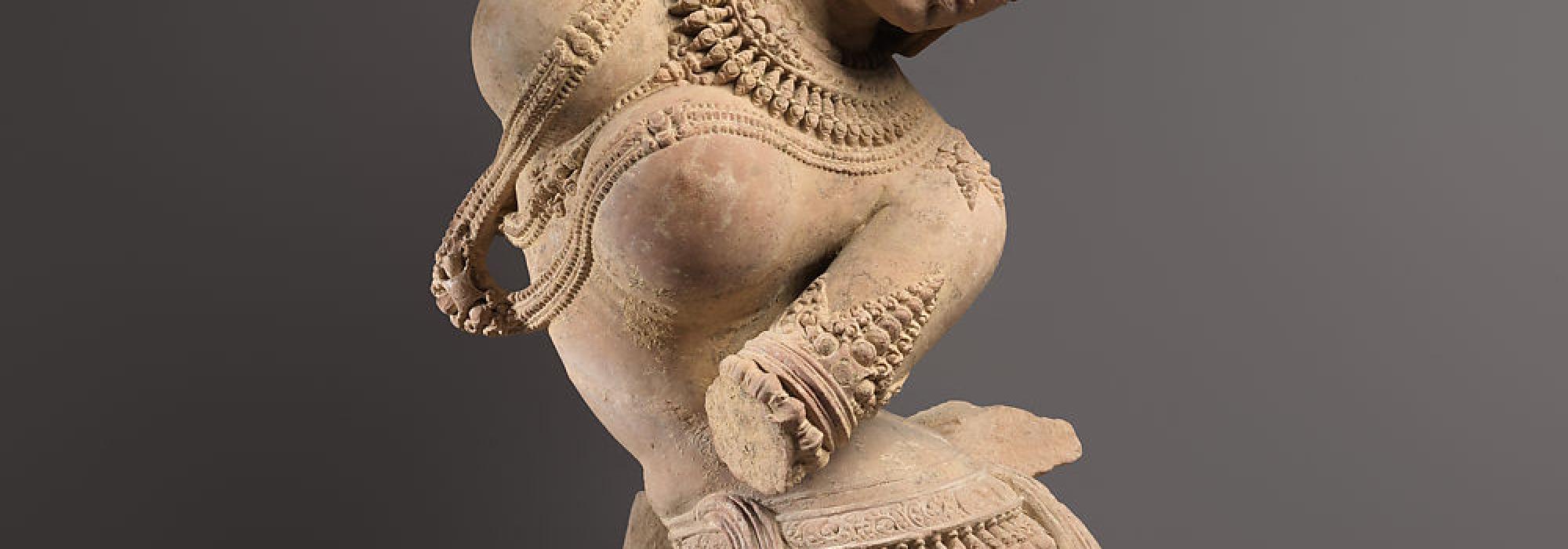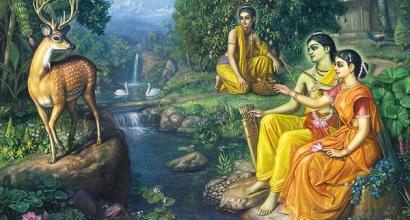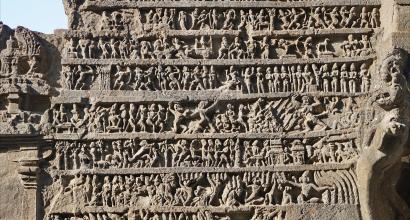The aesthetics of group dance is compromised because choreographers fail to keep track of the changes that a solo performing art needs to undergo in the process of adapting itself to a group performance. The effort is like trying to put a square nut into a circular hole. Unless we go to the level of abstraction and examine things, no transformation can successfully take place. For example, to turn a bronze sculpture of Gaṇapati into one of Śrīkṛṣṇa, we will need to first melt the sculpture we have with us. Then we will need to recast the bronze so obtained into the image of Śrīkṛṣṇa. To transform a work of art, prodigious talent should act as heat and deep erudition should act as the mould. In sum, there is no option other than turning to ekāhārya or ekahārya presentations.
In order to achieve this, a dance concert should not be a collage of ten or twenty different aspects; it should limit itself to only one or two major elements. It will need to have a common sthāyi throughout and should narrate just one story. It is important to elaborate every episode of the story through abhinaya. The episodes chosen should be short, but the dancer should add value to it by filling it with details. For example, a rāga that is chosen for presentation in a musical concert must be creatively elaborated in all possible dimensions. In this manner, the audience get a wholesome perspective of the rāga. Dr. Padma Subrahmanyam adapted classical dance to a genre of presentation called Bhāṇika and her performances have been supremely successful. It is inevitable for artistes to gain maturity and grow to her heights to make significant contributions to the field.
Programs such as ‘Dance at Your Doorstep’ (Kannada: ಮನೆಯಂಗಳದಲ್ಲಿ ನೃತ್ಯ (Maneyaṅgaḻadalli nṛtya) have an advantage – they can bring out the full potential of dance by doing a detailed mukhajābhinaya – facial expressions. The audience is seated very close to the artistes. This can, in fact, be a disadvantage too, if the artistes are not talented enough to perform impactful abhinaya. Such programs help their audience to understand the importance of dance as a classical form of art and to realise the real potential of the art form.
Classical literature too has evolved in the same fashion. The famous poetician Kuntaka says –
nirantararasodgāragarbhasandarbhanirbharāḥ|
giraḥ kavīnāṃ jīvanti na kathāmātram āśritaḥ||Vakrokti-jīvita 4.13
(Poetic expressions come to life
only when they are rich with evocative incidents,
and not when they merely narrate a story)
For poetry to be rich in rasa, the poet will need to give primary importance to detailing (varṇanā) and not merely stick to narrating the story.
For example, instead of plainly stating that Rāma married Sītā, it would be more beautiful to say ‘Rāma put the bridal garland around Sītā.’ The following is the manner in which the Kannada poet Nāgacandra says the same thing: “Sītā’s glances moved like a garland of bees around the bridal garland she carried. She put the garland around Rāma’s neck and while doing so, her tender arms appeared like a garland.” The poet has used the image of garland in different ways, one after the other. It would be special to enact this through stylized abhinaya. If this scene appears in a movie, it will get over in a second’s time. At the most, it might last for half a minute. The camera used for cinematography will capture the scene from different angles. Due to the advancement in technology, it is possible to show bees buzzing around the garland quite realistically. However, in classical dance, this entire sequence can be captured in all its detail by a capable artiste with her abhinaya. It can be elaborated for ten to fifteen minutes. The gentleness of the garland, the waves of emotion in Sītā’s mind as she strings the garland together, the shyness she experiences when she first sees Rāma, the shivering of her body, perspiration and other sāttvika-bhāvas – all of this can be effectively displayed. In addition, rūpakālaṅkāra (metaphor) can be brought out through abhinaya – the movement of her eyes resembling a bee and the bees that surround the garland moving around like her eyeballs: this kind of bimba-pratibimba (image and reflection) can be portrayed creatively. A talented artiste can also add more elements. Aravinda, aśoka, nīlotpala and other flowers that constitute Manmatha’s arrows can be depicted as a part of the garland that Sītā is carrying. The fully blossomed lotus resembling Sītā’s alit face, the white lotus turning pink due to Sītā’s touch, and the white lotus turning blue as the garland falls around the neck of blue-complexioned Rāma can be portrayed by the artiste. The artiste can even depict how Rāma, out of his bashfulness, refused to receive the garland from Sītā and the manner in which Sītā, with the play of her eyes, gently convinces Rāma to accept her. Following this, Rāma’s graceful smile of acceptance and the garlanding of Sītā. There are several such possibilities…!
An artiste who can put on the roles of several different characters at the same time can take to performing ekāhārya/ ekahārya presentation. This will enhance the beauty of the performance. This must be accompanied by lyrics rich in emotions, creative music, and wholesome āṅgika and sāttvika.
The lyrics that accompany nṛtya-nāṭakas today lack beauty. Further, only a limited number of rāgas are used in music. For a ninety-minute ekāhārya presentation to capture the hearts of the audience, about twenty to twenty-five rāgas need to be used. The geya-prabandhas (roughly translated as ‘lyrics’) must be rich in arthālaṅkāras and śabdālaṅkāras (figures of sound and sense respectively). Movements used should employ karaṇas and aṅgahāras as described in the Nāṭyaśāstra. In cinema, a flamboyant display of various external features suffices. This is not the case with nṛtya. It has to attract true connoisseurs. If they have to watch a performance that goes on for an hour or two, the artiste cannot rely solely on external parameters. Flamboyance is essential for the material world, but enrichment of our inherent strengths will certainly help our art leave a mark.
Movement is the basis for dance and sattva is fundamental to movement. If sattva isn’t ātmāśrita (rooted in one’s own self), Rasa cannot get evoked. The ability of the artiste to show the blossoming of different emotions determines the success of her art.
Our skin may go dry when it is cold outside. We apply moisturizing cream and different kinds of oil to keep our skin intact. Our internal health needs something that is called ṛtucaryā in ārogya-śāstra (science of health). We must consume food rich in glucose and oil. Enthusiasm and inspiration must come from within the artiste. Just as bulbs can glow only if there is electricity flowing through the wires, an artiste can be radiant on the stage only if she has the internal spark.
It is harmful to the growth of any form of art in general, and dance in particular if it wishes to isolate itself from the rest of the world (and other forms of art). Being conscious about the needs of the world and the aesthetics of the art – both are important for the performance of any art. We must examine how a movement contributes to evoking Rasa. Then we will realise that all movements should take shape as a function of vibhāva and anubhāva. This indeed is the secret of Rasa!
Concluded
This series of articles are authored by Shatavadhani Dr. R Ganesh and have been rendered into English with additional material and footnotes by Arjun Bharadwaj. The article first appeared in the anthology Prekṣaṇīyaṃ, published by the Prekshaa Pratishtana in Feburary 2020.














































